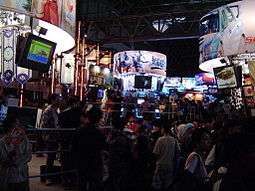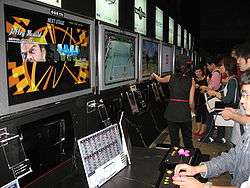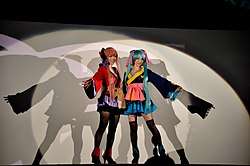Tokyo Game Show
| Tokyo Game Show | |
|---|---|
|
| |
 Former logo of Tokyo Game Show (1996-2010) | |
| Status | Active |
| Genre | Video games |
| Venue | Makuhari Messe |
| Location(s) | Chiba |
| Country | Japan |
| Inaugurated | August 22, 1996 |
| Attendance | 268,446 (2015)[1] |
| Organized by |
Computer Entertainment Supplier's Association (CESA) Nikkei Business Publications, Inc. |
| Sponsor | Ministry of Economy, Trade and Industry (METI) |
| Website | http://tgs.cesa.or.jp/ |
Tokyo Game Show (東京ゲームショウ Tōkyō Gēmu Syō), commonly known as TGS, is a video game expo / convention held annually in September in the Makuhari Messe, in Chiba, Japan. It is presented by the Computer Entertainment Supplier's Association (CESA) and Nikkei Business Publications, Inc. The main focus of the show is on Japanese games, but some international video game developers use it to showcase upcoming releases/related hardware. The duration of the event is four days. The first two days of Tokyo Game Show are open only to industry attendees (business) and the general public can attend during the final two days.
History


The first Tokyo Game Show was held in 1996.[2] From 1996 to 2002, the show was held twice a year: once in the Spring and once in Autumn (in the Tokyo Big Sight).[3] Since 2002, the show has been held once a year. It attracts more visitors every year. 2011’s show hosted over 200,000 attendees and the 2012 show bringing in 223,753. The busiest TGS was in 2016 with 271,224 people in attendance and 614 companies had exhibits.[4] The event has been held annually since 1996 and was never canceled. The 20th anniversary of TGS was celebrated in 2016.[5]
Layout
The TGS layout varies per year. Such as in 2015, the Tokyo Game Show showcased 11 exhibition areas consisting of business, general public, education and other areas to buy merchandise.
General Exhibition
The General Exhibition Area is the heart of the show, taking up the largest amount of space, and is held where digital gaming entertainment or any related products or services are showcased. Many well-known companies such as Namco Bandai, Capcom, Sony Computer Entertainment and Square Enix have demo areas here, in addition to emerging companies.
Game Device
This area covers gaming devices such as headphones, controllers, furniture and other devices associated with home-use gaming consoles and portable gaming devices.
Asia New Stars
An exhibition introduced at the 2012 Tokyo Game Show is geared towards introducing emerging game developers from Asia.
Merchandise Sales
This area is designated for merchandising of game-related goods. Vendors include Konami and Square-Enix.
Smartphone and social games
This area focuses on games for smart devices (smartphones and tablets) and social games. Despite record numbers during TGS 2012, many large companies had a smaller presence. For example, Microsoft, which previously had one of the largest booths, was absent in 2012. Social and mobile gaming surged, filling the gap. Microsoft returned to the show in 2013 with the release of the Xbox One.[6]
Personal computing
The PC area houses major Japanese computing companies, showcasing products such as Japanese desktop and notebook computers.
Children
This area showcases new games that are aimed at a younger audience. Companies such as Taito and Sega are housed there.[7]
Game school
The Game School area showcases information on Japanese universities and colleges offering information about digital art, animation, computer programming, and other programs of study related to the video game industry. These booths also display student work. It houses colleges such as Numazu Professional College of Information Technology and Tokyo Designer Gakuin College.[7]
Sales
This is the main area in the games convention where most of the sales and business transactions between companies and consumers are carried out. Companies housed there include Nikkei Business Publications.[7]
Cosplay

The Tokyo Game Show attracts many cosplayers. Cure, Japan's largest cosplay community website, hosted a "Moving Cosplay" stage show during the 2012 edition. The show lasted 90 minutes and included a cosplay fashion show, dance numbers and a grand march of robot cosplayers. The event was attended by top cosplayers from Japan and overseas and by local amateurs.
Business solutions
This is the main business area and is not open to the public.[7]
Cloud/data center pavilion
The Cloud/Data Center is dedicated to improving infrastructure and environment of social and network games.
Street Fighter tournaments
The Tokyo Game Show has featured a Mad Catz-sponsored Street Fighter tournament since 2014. The competition is part of Capcom's official Pro Tour, making it a qualifying event for the Capcom Cup. The 2016 event was the first to not be sponsored by Mad Catz, as the company got in severe financial trouble during its 2016 fiscal year.[8]
See also
References
- ↑ http://www.playstationlifestyle.net/2015/09/20/tokyo-game-show-2016-dates-tgs-2015-attendance/#/slide/1
- ↑ "Tokyo Game Show". Expo.nikkeibp.co.jp. Retrieved 2010-10-14.
- ↑ "TOKYO GAME SHOW 2001 AUTUMN". Cesa.or.jp. 2001-10-12. Archived from the original on 2010-10-08. Retrieved 2010-10-14.
- ↑ "東京ゲームショウ2016結果速報" (PDF). Tokyo Game Show. September 18, 2016. Retrieved September 20, 2018.
- ↑ "東京ゲームショウ2016開幕直前情報" (PDF). Tokyo Game Show. September 7, 2016. Retrieved September 20, 2018.
- ↑ "Microsoft reveals Xbox One plans for Tokyo Game Show 2013". Neowin. Retrieved 2014-06-14.
- 1 2 3 4 "東京ゲームショウ". Computer Entertainment Supplier's Association. Retrieved 22 September 2009.
- ↑ Jurek, Steven (2016-04-15). "Mad Catz will not sponsor the Capcom Pro Tour event at Tokyo Game Show". The Daily Dot.
External links
| Wikimedia Commons has media related to Tokyo Game Show. |